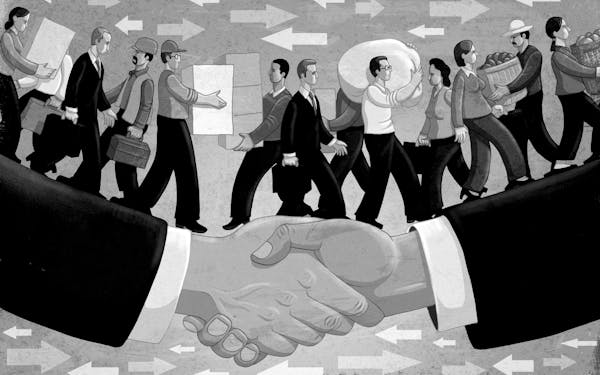In his 1935 book "Politics, Pressures, and the Tariff," American political scientist E.E. Schattschneider described foreign trade as the fulcrum of interest group politics in the United States. The economic benefits of free trade are broad and diffuse, while the costs are narrow and concentrated. As a result, the political economy of foreign trade favors small, well-organized protectionist lobbies that defeat trade liberalization.
Schattschneider's analysis reflected the protectionist surge of the 1930s, manifested by the Smoot Hawley Tariff Act that raised duties on U.S. imports to nearly 60 percent. Economic historians regard Smoot Hawley as a policy disaster that triggered retaliatory tariffs by American trading partners, causing global trade to fall by two-thirds and needlessly prolonging the Great Depression.
The "concentrated costs, diffuse benefits" problem still underpins the politics of foreign trade. Numerically small but politically powerful protectionist groups (ranging from American steel manufacturers to French wine producers to Japanese rice growers) secure tariffs and non-tariff barriers to defend their market positions against foreign competitors.
Nonetheless, the proponents of free trade enjoyed notable successes after World War II. Filling the institutional vacuum that invited the trade wars of the 1930s, the GATT (General Agreement on Tariffs and Trade) conducted a series of multilateral trade negotiations that reduced tariffs on merchandise goods to historically low levels. The successor WTO (World Trade Organization) created legal procedures to adjudicate trade disputes and formulated rules to facilitate trade in services, which represent a large and growing share of international trade.
Parallel with multilateral trade liberalization, regional and bilateral trade agreements proliferated in Africa, Asia, Europe and the Americas. Such agreements remain controversial among trade economists anchored to the multilateral principle of nondiscrimination. However, regional/bilateral trade agreements have proved a valuable policy instrument for countries unable to realize their foreign trade objectives through the multilateral system.
Collectively, these movements toward trade liberalization have yielded manifest gains for global, national and regional economies: Increased growth, heightened productivity, strengthened competitiveness. Free trade also generates clear benefits at the microeconomic level. Global trade enables companies based in small countries to scale out their domestic markets and widens foreign sourcing options for manufacturers dependent on specialized inputs. Furthermore, liberalized trade gives consumers access to a broader range of goods and services, at lower cost and higher quality.
Scholarly research indicates that trade liberalization also promotes job creation, a critical factor in the post-Great Recession period when many national governments have exhausted their capacity for fiscal and monetary stimulus. For that reason, the Obama administration launched the National Export Initiative that aims to double U.S. exports and create 2 million new jobs. Trade policy officials regard export promotion as a job-creation accelerator, spurring growth in direct export-related employment, as well as indirect job creation by local suppliers and service providers.
Trade promotion in a slow-growth environment drives current negotiations between the United States and the European Union to form the TTIP (Transatlantic Trade and Investment Partnership). With $4.7 trillion in annual trade and investment, the transatlantic theater comprises the world's largest commercial arena. Outside of agriculture, conventional barriers to trade between the U.S. and the E.U. are already low as a result of WTO-bound tariffs. The TTIP's primary contribution would come through regulatory harmonization, reduction of bureaucratic duplication, and increased access to service and procurement markets.
According to the London-based Centre for Economic Policy Research, the proposed transatlantic accord would boost annual GDP in the E.U. by 0.5 percent and U.S. GDP by 0.4 percent. Compounded over time, such yearly increments to GDP growth would yield substantial gains for the American and European economies.
Trade economists do not seriously dispute the economic benefits of trade liberalization. But their views do not align with recent public opinion polls, which show weak and declining popular support of free trade in the United States.
A representative NBC News/Wall Street Journal poll conducted in fall 2010 found that 23 percent of respondents believed that free trade agreements had helped the United States, vs. 47 percent who said they had harmed the country.
Polls also reveal interesting trends in partisan views of trade liberalization. A larger share of Republican respondents viewed free trade agreements as bad for the United States than Democrats (54 percent vs. 35 percent). Tea Partiers voiced the greatest skepticism about free trade (63 percent).
These results demonstrate that public education about the economic benefits of foreign trade is vital in a highly charged political environment where the objections of tightly organized protectionist groups often prevail.
David Bartlett is senior lecturer at the University of Minnesota's Carlson School of Management.
The courage to follow the evidence on transgender care

Republicans wanted a crackdown on Israel's critics. Columbia obliged.


